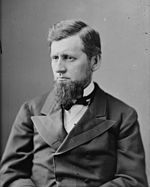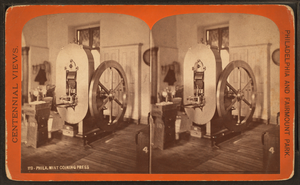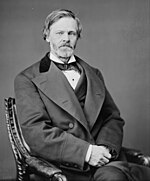This is an old revision of this page, as edited by Racepacket (talk | contribs) at 21:41, 4 January 2011 (good article). The present address (URL) is a permanent link to this revision, which may differ significantly from the current revision.
Revision as of 21:41, 4 January 2011 by Racepacket (talk | contribs) (good article)(diff) ← Previous revision | Latest revision (diff) | Newer revision → (diff)| United States | |
| Value | 1 U.S. dollar |
|---|---|
| Mass | 26.73 g |
| Diameter | 38.1 mm |
| Thickness | 2.9 mm |
| Edge | Reeded |
| Composition | 90.0% Silver 10.0% Copper |
| Years of minting | 1878–1904, 1921 |
| Obverse | |
 | |
| Design | Liberty |
| Designer | George T. Morgan |
| Design date | 1878 |
| Reverse | |
 | |
| Design | Eagle clasping arrows and olive branch |
| Designer | George T. Morgan |
| Design date | 1878 |
The Morgan dollar is a United States dollar coin minted intermittently from 1878 to 1921. It was the first standard silver dollar minted since production of the Seated Liberty dollar ceased due to the passage of the Fourth Coinage Act. The coin is named for its designer, George T. Morgan. Morgan's design was based on work previously done by him on earlier pattern coins The obverse depicts a profile portrait representing Liberty, while the reverse depicts an eagle with wings outstretched. Both Morgan and then Chief Engraver William Barber submitted designs for the dollar; Mint Director Dr. Henry Richard Linderman recommended those of Morgan.
The dollar was authorized by the Bland–Allison Act. Following the passage of the Fourth Coinage Act, which ended the free coinage of silver and the mintage of silver dollars, mining interests lobbied to restore the free coinage. Instead, when the Bland–Allison Act was passed, the Treasury was required to purchase between two and four million dollars worth of silver to be coined into dollars each month. Later, in 1890, the Bland–Allison act was repealed. The new provision, under the Sherman Silver Purchase Act, required the Treasury to purchase 4,500,000 ounces of silver each month, but only required silver dollar production for one year. This act, in turn, was repealed in 1893. In 1898, an act was approved that required all remaining bullion purchased under the Sherman Silver Purchase Act be coined into silver dollars. In 1904, silver reserves were depleted. The Pittman Act, passed in 1918, authorized the melting and recoining of millions of silver dollars. Under the act, Morgan dollars resumed mintage for one year, 1921. The design was replaced by the Peace dollar in the same year.
In the early 1960s, a large amount of uncirculated Morgan dollars were found to be available from Treasury vaults. Individuals began purchasing quantities of the coins when it was discovered that rare issues could be purchased at face value. Beginning in the 1970s, the Treasury conducted a sale of silver dollars minted at the Carson City Mint through the General Services Administration.
Background

In 1873, Congress enacted the Fourth Coinage Act. The act effectively ended the bimetallic standard in the United States by demonetizing silver. The act also ended the production of the standard silver dollar, though authorizing trade dollars, which were officially demonitized the following year. The last silver dollar minted before passage of the act was the Seated Liberty dollar, as designed by Christian Gobrecht. Prior to enactment of the Coinage Act, silver could be brought to the mints in order to be coined into legal tender. With such a system in place, bullion producers could have silver coined into dollars when the intrinsic value of a silver dollar was lower than the face value, thus making a profit. The act initially met little resistance from mining interests until the price of silver declined rapidly due to increased mining efforts in the Western United States. Protests also came from bankers, manufacturers and farmers. Groups were formed that demanded the free coinage of silver (or "Free Silver") in order to inflate the dollar. This course of action was intended partly as a means of relief for the nation's farmers following the Panic of 1873.

Beginning in 1876, several bills were introduced in the United States House of Representatives resume coinage of the standard silver dollars. One such bill introduced into the House by representative Richard P. Bland was passed in the fall of 1876. Senator William B. Allison added important amendments to the bill in the Senate. One amendment struck the provision to again allow the free coinage of silver, which was present in the House version of the bill. This same amendment allowed for the issuance of silver certificates for the first time in United States history. The bill, which became known as the Bland–Allison Act, was vetoed by President Rutherford B. Hayes. The veto was overriden by Congress on February 28, 1878. The act required that the Treasury purchase between two and four million dollars worth of silver per month, to be coined into silver dollars at the former gold/silver ratio of 16:1.
Design history

In 1876, Director of the Mint Dr. Henry Richard Linderman began efforts to redesign the nation's silver coins. Linderman contacted C.W. Fremantle, Deputy Master of the Royal Mint in London, requesting him to "find a first class die-sinker who would be willing to take the position of Assistant Engraver at the Mint at Philadelphia." In response to Linderman's request, Fremantle wrote "My inquiries as to an Assistant Engraver lead me very strongly to recommend for the post Mr. George Morgan, age 30, who has made himself a considerable name, but for whom there is not much opening at present in this country." An agreement was reached between Linderman and Morgan for the engraver to work at the Philadelphia Mint on a six-month trial.
Morgan arrived in Philadelphia on October 9, 1876. His earliest pattern coins designed during his tenure at the Philadelphia Mint were intended for the half dollar. In 1876, Morgan enrolled as a student at the Pennsylvania Academy of the Fine Arts in order to prepare for creating a new Liberty head design. Morgan also obtained studies from nature of the bald eagle for preperation of the reverse design. For the representation of Liberty, Morgan sought to depict an American woman rather than the usual Greek–style figures. Morgan's friend, artist Thomas Eakins, suggested he use Anna Willess Williams of Philadelphia as a model. In total, Morgan had five sittings with Williams; he declared her profile to be the most perfect he had seen.

On October 18, 1877, Linderman requested Superintendent of the Philadelphia Mint James Pollock to "instruct Mr. Morgan to prepare without delay, dies for a silver dollar, the designs, inscriptions, and arrangement thereof to be the same as the enclosed impression for the Half Dollar and numbered '2' substituting the words 'one dollar' in place of 'half dollar,' and that you will cause six impressions to be struck in standard silver of 412½ grains weight, and transmit the same to this office." Linderman also ordered Pollock to "instruct Mr. Barber to prepare a reverse die for a dollar with a representation of an eagle as well as the inscriptions required by law. He will select whichever of his Heads of Liberty he prefers for the obverse of the same." Barber was Chief Engraver at that time. Linderman evidently preferred the designs of Morgan over those of the Chief Engraver; he wrote Pollock on February 21, 1878, "I have now to state for your information, that it is my intention, in the event of the silver bill now pending in Congress, becoming law, to request the approval by the Secretary of the Treasury, of the dies prepared by Mr. Morgan."
Production
Due to a delay in manufacturing dies to strike the new coins, production did not commence until March 11, more than a week after the passage of the Bland–Allison Act. The first acceptable strike, after adjustments to the press, was coined at 3:17 p.m. in the Philadelphia Mint. This piece was given to President Hayes. The second and third were given to Secretary of the Treasury John Sherman and to Henry Linderman respectively.

Linderman desired to involve the western mints of San Francisco and Carson City in production in order to help reach the monthly quota necessary under the Bland–Allison Act. Pressure was so great that the Philadelphia Mint halted production of all other coins and began operating overtime. This was delayed, however, as all dies were prepared at the Philadelphia Mint, and it was believed that the Western mints did not have the proper equipment to prepare the dies for use. During the second week of production, Linderman pointed out what he called a "slight imperfection" in the dies for the dollar. The reason for the changes was to reduce the relief of the designs and to change the number of tail feathers on the eagle from eight to seven. This was done because all prior coinage depicted the bald eagle as having an odd number of tail feathers. The high relief had caused the dies to have a shorter life. Dies were eventually sent to the Western mint, arriving in both San Francisco and Carson City on April 16, 1878. The New Orleans Mint began minting the new silver dollars in 1879. The Denver Mint struck the coins for only one year, 1921.
Sherman Silver Purchase Act
Main article: Sherman Silver Purchase Act
Mintage of the Morgan dollar remained relatively steady until the passage of the Sherman Silver Purchase Act on July 14, 1890. The act, authored by Ohio senator and former Treasury secretary John Sherman, forced the Treasury to increase the amount of silver purchased to 4,500,000 ounces each month. The act also stated that the Mints must coin 2,000,000 silver dollars each month only until 1891. Since the Treasury already had a surplus of the silver dollars, mintages dropped sharply beginning in 1892. In June of 1893, President Grover Cleveland called a special session of Congress. Cleveland, who believed that the Panic of 1893 was caused by the Sherman Silver Purchase Act, called the session in order to repeal it. The act was repealed on November 1, 1893. On June 13, 1898, an act was passed that required the coining of all the remaining bullion purchased under the Sherman Silver Purchase Act into silver dollars. Silver dollar production rose again, until reserves were depleted in 1904.
Pittman Act
Main article: Pittman Act
In 1918, Nevada senator Key Pittman introduced legislation that was largely meant as relief for the British government during World War I. The bill, passed on April 22, 1918, states that "sales of silver bullion under authority of this act may be made for the purpose of conserving the existing stock of gold in the United States, of providing silver for subsidiary coinage and for commercial use, and of assisting foreign governments at war with the enemies of the United States." The reason for the United Kingdom's need was a propaganda campaign of the German government. The Germans convinced citizens of India that the silver certificates issued by the British government could not be redeemed, which caused a run on the British supply of silver. The Pittman Act authorized the melting of "not more than 350,000,000" silver dollars. The melting of the silver dollars began immediately after the passage of the act. A total of 270,232,722 silver dollars were melted. Of this amount, 259,121,554 were sold to the United Kingdom at the cost of one dollar per ounce. Another provision of the Pittman act authorized the coinage of a replacement for every silver dollar melted. Mintage of the Morgan dollar resumed for only one year, 1921. Since all obsolete coinage dies had been destroyed in 1910, Morgan was forced to create an entirely new master die for the dollar. 1921 also marked the first issuance of the Peace dollar, as a coin to commemorate the resulting peace after World War I. This replacement of the Morgan dollar was issued under the terms of the Pittman act without congressional authorization, despite the fact that the act makes no mention of the design of the coins. The change in design was actually authorized under an 1890 act of Congress, which stated:
"no change in the design or die of any coin shall be made oftener than once in twenty-five years from and including the year of the first adoption of the design, model, die, or hub for the same coin:
Provided, That no change be made in the diameter of any coin:
And provided further, That nothing in this section shall prevent the adoption of new designs or models for devices or emblems already authorized for the standard silver dollar and the five-cent nickel piece as soon as practicable after the passage of this act."
Treasury release and General Services Administration sales
Between November 1962 and March 1964, millions of Morgan and Peace dollars were sold to the general public. Interest began in 1962, when a date of Morgan dollar that was previously considered very rare was discovered in a bag of silver dollars taken from a vault of the Philadelphia Mint. The demand to exchange silver certificates for uncirculated silver dollars was so great that lines formed outside of the Treasury Building in Washington, D.C., with some of those in line pushing wheelbarrows. Upon discovering bags of Carson City–minted dollars, Treasury officials decided to hold them back as mintage totals from that mint were generally lower than others.
On May 12, 1969, the Joint Commission on Coinage held a meeting in order to determine how best to dispose of the Carson City–minted dollars earlier held back by Treasury officials. They recommended a mail bid sale. Legislation was passed on December 31, 1970 stating:
"The Secretary of the Treasury is authorized to transfer, as an accountable advance and at their face value, the approximately three million silver dollars now held in the Treasury to the Administrator of General Services. The Administrator is authorized to offer these coins to the public in the manner recommended by the Joint Commission on the Coinage at its meeting on May 12, 1969. The Administrator shall repay the accountable advance in the amount of that face value out of the proceeds of and at the time of the public sale of the silver dollars. Any proceeds received as a result of the public sale in excess of the face value of these coins shall be covered into the Treasury as miscellaneous receipts."
Congress supplied the General Services Administration with ten million dollars to market the dollar coins. Advertising consisted of posters and brochures distributed to post offices, banks and various financial institutions, as well as television documentaries. The coins were sorted and put into small plastic display cases. The Administration conducted a total of seven mail bid sales between 1972 and 1980. In total, the sales generated $107 million.
References
- Van Allen & Mallis, p. 21
- ^ Fite, p. 428
- ^ Van Allen & Mallis, p. 23
- Yeoman, p. 17
- Yeoman, p. 215
- ^ Van Allen & Mallis, p. 24
- ^ Rutherford B. Hayes. senate.gov. Retrieved 12-18-2010
- Fite, p. 429
- ^ Van Allen & Mallis, p. 73
- Van Allen & Mallis, p. 74
- ^ Van Allen & Mallis, p. 75
- Van Allen & Mallis, p. 79
- Van Allen & Mallis, p. 83
- ^ Van Allen & Mallis, p. 84
- Van Allen & Mallis, p. 86
- ^ Van Allen & Mallis, p. 88
- ^ Van Allen & Mallis, p. 87
- Van Allen & Mallis, p. 90
- Yeoman, p. 218
- ^ Yeoman, p. 220
- ^ Yeoman, p. 219
- Fite, p. 446
- ^ Van Allen & Mallis, p. 29
- ^ Van Allen & Mallis, p. 30
- ^ Van Allen & Mallis, p. 31
- ^ Van Allen & Mallis, p. 32
- Van Allen & Mallis, p. 95
- ^ Yeoman, p. 221
- Van Allen & Mallis, p. 409
- Richardson, William Allen, ed. (1891). Supplement to the revised statutes of the United States. Vol. 1. Washington, D.C.: US Government Printing Office. pp. 806–807. 26 Stat L. 484, amendment to R.S. §3510
- ^ Yeoman, pp. 27–28
- ^ Van Allen & Mallis, pp. 397–402
- Department of the Treasury, Bureau of the Mint (1972). Domestic and Foreign Coins Manufactured by Mints of the United States 1793-1970. Washington, D.C.: U.S. Government Printing Office., pp. 137–138
Bibliography
Van Allen, Leroy C. & Mallis, A. George (1991). Comprehensive Catalog and Encyclopedia of Morgan & Peace Dollars. Virginia Beach, Virginia: DLRC Press. ISBN 1880731118.{{cite book}}: CS1 maint: multiple names: authors list (link)
Fite, Emerson David (1919). History of the United States (second ed.). New York, NY: Henry Holt and Company. {{cite book}}: External link in |title=
Yeoman, R.S. (2010). A Guide Book of United States Coins (63rd ed.). Atlanta, GA: Whitman Publishing, LLC. ISBN 0794827675.
| Preceded bySeated Liberty Dollar | Dollar Coin of the United States (1878–1904, 1921)
Concurrent with: Trade Dollar (1878–1885) Large Head Indian Gold Dollar - Type III (1878–1889) Peace Dollar (1921) |
Succeeded byPeace Dollar |
| Coinage of the United States | |
|---|---|
| Circulating | |
| Obsolete | |
| Canceled | |
| Commemorative | |
| Bullion |
|
| Special sets |
|